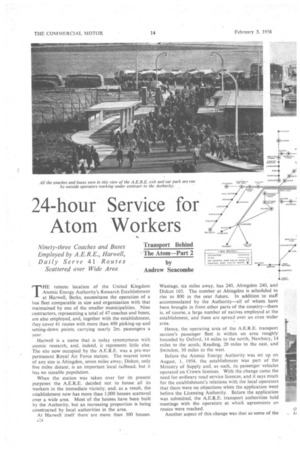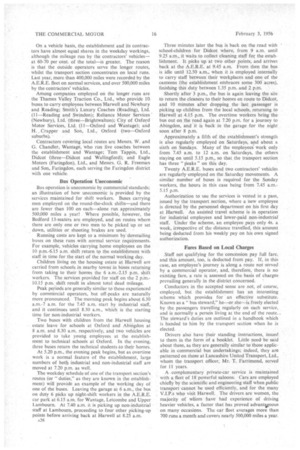24-hour Service for Atom Workers
Page 26

Page 27

Page 28

If you've noticed an error in this article please click here to report it so we can fix it.
Ninety-three Coaches and Buses Employed by A.E.R.E., Harwell, Daily Serve 41 Routes Scattered over Wide Area
THE remote location of the United Kingdom Atomic Energy Authority's Research Establishment at Harwell, Berks, necessitates the operation of a bus fleet comparable in size and organization with that maintained by one of the smaller municipalities. Nine contractors, representing a total of 47 coaches and buses, are also employed, and, together with the establishment, they cover 41 routes with more than 400 picking-up arid setting-down points, carrying nearly 2m. passengers a year.
Harwell is a name that is today synonymous with atomic research, and, indeed, it represents little else. The site now occupied by the A.E.R.E. was a pre-war permanent Royal Air Force station. The nearest town of any size is Abingdon, seven miles away; Didcot, only five miles distant, is an important local railhead, but it has no sizeable population.
When the station was taken over for its present purposes the A.E.R.E. decided not to house all its workers in the immediate vicinity, and, as a result, the establishment now has more than 1,000 houses scattered over a wide area. Most of the houses have been built by the Authority, but an increasing proportion is being constructed by local authorities in the area.
At Harwell itself there are more than 300 houses. A24 Wantage, six miles away, has 240, Abingdon 240, and Dideot 165. The number at Abingdon is scheduled to rise to 800 in the near future. In addition to staff accommodated by the Authority—all of whom have been brought in from other parts of the country—there is, of course, a large number of natives employed at the establishment, and these are spread over an even wider area.
Hence, the operating area of the A.E.R.E. transport section's passenger fleet is within an area roughly bounded by Oxford, 14 miles to the north, Newbury, 14 miles to the south, Reading, 20 miles to the east, and Swindon, 30 miles to the west.
Before the Atomic Energy Authority was set up on August, 1, 1954, the establishment was part of the Ministry of Supply and, as such, its passenger vehicles operated on CroWn licences. With the change catne.the need for ordinary road service licences, and it says much for the establishment's relations with the local operators that there were no objections when the application went before the Licensing Authority. Before the application was submitted, the A.E.R.E. transport authorities held meetings with the operators at which agreements on routes were reached.
Another aspect of this change was that as some of the . ki
vehicles in the fleet did not comply with Ministry of Transport regulations, they had to be modified accordingly. An example was a number of 1f-deck coaches acquired from British Overseas Airways Corporation. In their original form these vehicles did not pass the tilt test, and a number of seats had to be removed from the upper deck to enable them to do so.
Today, the section operates 46 passenger vehicles, many of them purchased second-hand from the London Transport Executive and other sources. Bedford is the most prominent make, there being 20 coaches of this type with Spurting and Duple bodies, seating capacities ranging from 13 to 40. Commer is represented by 12 single-deckers (three with 18 seats and nine with 26 seats), and there are 14 Guy-Park Royal 56-seat doubledeck ers.
Sonic of the buses still retain their drab M.o.S. khakigreen colour, but when they are due for re-painting they will join the rest of the fleet in the establishment's distinctive and tasteful livery of azure blue and Quaker grey. On a vehicle basis, the establishment and its contractors have almost equal shares in the weekday workings, although the mileage run by the contractors' vehicles— at 60-70 per cent, of the total—is greater. The reason is that the outside operators serve the longer routes, whilst the transport section concentrates on local runs. Last year, more than 400,000 miles were recorded by the A.E.R.E. fleet on normal services, and over 500,000 miles by the contractors' vehicles.
Among companies employed on the longer runs are the Thames Valley Traction Co., Ltd., who provide 10 buses to carry employees between Harwell and Newbury and Reading; Smith's Luxury Coaches (Reading), Ltd. (11—Reading and Swindon); Reliance Motor Services (Newbury), Ltd..(three—Brightwalton); City of Oxford Motor Services, Ltd. (11—Oxford and Wantage); and H. . Crapper and Son, Ltd., Oxford (two—Oxford suburbs).
Contractors covering local routes are Messrs. W. and G. Chandler, Wantage, who run five coaches between the establishment and Wantage; Tom Tappin, Ltd., Didcot (three—Didcot and Wallingford); and Eagle Motors (Faringdon), Ltd., and Messrs. G. R. Freeman and Son, Faringdon, each serving the Faringdon district with one vehicle.
Bus Operation Uneconomic
Bus operation is uneconomic by commercial standards; an illustration of how uneconomic is provided by the services maintained for shift workers. Buses carrying men employed on the round-the-clock shifts—and there are fewer than 100 on each—alone run approximately 500,000 miles a year! Where possible, however, the Bedford 13-seaters are employed, and on routes where there are only one or two men to be picked up or set down, utilities or shooting brakes are used.
Running costs are kept to a minimum by dovetailing buses on these runs with normal service requirements. For example, vehicles carrying home employees on the 10 p.m.-6.15 a.m. shift return to the establishment with staff in time for the start of the normal working day.
Children living on the housing estate at Harwell are carried from schools in nearby towns in buses returning from taking to their homes the 6 a.m.-2.15 p.m. shift workers. The services provided for staff on the 2 p.M.10.15 p.m. shift result in almost total dead mileage.
Peak periods are generally similar to those experienced by commercial operators, but off-peaks are naturally more pronounced. The morning peak begins about 6.30 a.m.-7 a.m. for the 7.45 a.m. start by industrial staff, and it continues until 8.30 a.m., which is the starting time for non-industrial workers.
Two buses with children from the Harwell housing estate leave for schools at Oxford and Abingdon at 8 a.m. and 8.30 a.m. respectively, and two vehicles are provided to take young employees at the establishment to technical schools at Oxford. In the evening, three buses return the technical students ,to their. homes.
At 5.20 p.m., the evening peak begins, but as overtime work is a normal feature of the establishment, large numbers of both industrial and non-industrial staff are moved at 7.20 p.m. as well.
The weekday schedule of one of the transport section's routes (or "duties," as they are known in the establishment) will provide an example of the working day of one of the buses. Leaving the garage at 6 a.m., the bus on duty 6 picks up night-shift workers in the A.E.R.E. car park at 6.15 a.m. for Wantage, Letcombe and Upper Lambourn. At 7.40 a.m. it is picking up non-industrial staff at Lambourn, proceeding to four other picking-up points before arriving back at Harwell at 8.25 a.m.
Three minutes later the bus is back on the road with school-children for Didcot where, from 9 a.m. until 9.25 a.m., it waits to collect cleaning staff for the establishment. It picks up at two other points, and arrives back at the A.E.R.E. at 9.45 a.rn. From then the bus is idle until 12.50 a.m., when it is employed internally to carry staff between their workplaces and one of the canteens (the establishment embraces some 300 acres), finishing this duty between L35 p.m. and 2 p.m.
Shortly after 3 p.m., the bus is again leaving the site to return the cleaners to their homes en route to Didcot, and 10 minutes after dropping the last passenger is picking up children from the local schools, returning to Harwell at 4.15 p.m. The overtime workers bring the bus out on the road again at 7.20 p.m. for a journey to Abingdon, and it is back in the garage for the night soon after 8 p.m.
Approximately a fifth of the establishment's strength is also regularly employed on Saturdays, and about a sixth on Sundays. Many of the employeeswork only from 7.45 a.m. to 12 a.m. on Saturdays, the others staying on until 5.15 p.m., so that the transport section has three " peaks " on this day.
Twenty A.E.R.E. buses and two contractors' vehicles are regularly employed on the Saturday movements. A similar number of buses is required for the Sunday workers, the hours in this case being from 7.45 a.m.5.15 p.m.
Authorization to use the services is vested in a pass, issued by the transport section, where a new employee is directed by the personnel department on his first day at Harwell. An assisted travel scheme is in operation for industrial employees and lower-paid non-industrial. staff. Under the scheme, an employee pays only 4s. a week, irrespective of the distance travelled, this amount being deducted from his weekly pay on his own signed authorization.
Fares Based on Local Charges
_Staff not qualifying for the concession pay full fare, and this amount, too, is deducted from pay. If, in this case, an employee's journey is along a route not served• by a commercial operator, and, therefore, there is no existing fare, a rate is assessed on the basis of charges prevailing generally in the district concerned.
Conductors in the accepted sense are not, of course, employed, but the establishment has an interesting scheme which provides for an effective substitute. Known as a" bus steward," he—or she—is freely elected by the passengers travelling regularly on each service, and is normally a person living at the end of the route. _ The steward's duties are outlined in a handbook which is handed to him by the transport section when he is elected.
Drivers also have their standing instructions, issued to them in the form of a booklet. Little need be said about these, as they are generally similar to those applicable in commercial bus undertakings; indeed, they are patterned on those at Lancashire United Transport, Ltd., whom the transport officer, Mr. T. Farrimond, served for 11 years.
A complementary private-car service is maintained with a fleet of 18 powerful saloons. Cars are employed chiefly by the scientific and engineering staff when public transport cannot be used efficiently, and for the many V.I.P.s who visit Harwell. The drivers are women, the majority of whom have had experience of driving heavier vehicles, a factor that has proved advantveous on many occasions. The car fleet averages more than 700 runs a month and covers nearly 500,000 miles a year.




















































